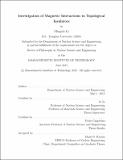| dc.contributor.advisor | Ju Li. | en_US |
| dc.contributor.author | Li, Mingda | en_US |
| dc.contributor.other | Massachusetts Institute of Technology. Department of Nuclear Science and Engineering. | en_US |
| dc.date.accessioned | 2016-07-18T19:10:56Z | |
| dc.date.available | 2016-07-18T19:10:56Z | |
| dc.date.copyright | 2015 | en_US |
| dc.date.issued | 2015 | en_US |
| dc.identifier.uri | http://hdl.handle.net/1721.1/103663 | |
| dc.description | Thesis: Ph. D., Massachusetts Institute of Technology, Department of Nuclear Science and Engineering, 2015. | en_US |
| dc.description | This electronic version was submitted by the student author. The certified thesis is available in the Institute Archives and Special Collections. | en_US |
| dc.description | Cataloged from student-submitted PDF version of thesis. | en_US |
| dc.description | Includes bibliographical references (pages 95-111). | en_US |
| dc.description.abstract | Topological insulators are a category of phases in condensed matter with inverted conduction and valence bands, which is protected by time reversal symmetry. As a result, the bulk keeps insulating while the surface supports an exotic high-mobility spin-polarized electronic states. Introducing magnetism into topological insulators will break the surface time reversal symmetry and alter the spin texture at the surface, and is an essential step to bring topological insulators towards the observation of new quantum states and for device applications. This thesis is a comprehensive study of magnetic interactions in topological insulators, from both experimental and theoretical perspective. Generically, there are two approaches to bring TI magnetic, the proximity effect and the conventional transitional metal ion doping. In the proximity effect, a layer of magnetic insulator is in proximally contact with a topological insulator, which forms a heterostructure and introduces magnetic exchange with the topological insulator states; while in the transitional metal ion doping, the magnetic dopants will induce magnetic order inside topological insulators. The main content and contribution of this thesis are five-fold. First and foremost, this thesis provides conclusive experimental evidence to demonstrate a long-predicted new type of magnetism, the "Van Vleck ferromagnetism" in magnetic topological insulator Vanadium doped Sb2Te3. Compared with the traditional RKKY magnetism in diluted magnetic semiconductors which needs undesired free carriers to mediate the magnetism, such magnetism has an carrier-free origin and solves the dark current issue for spintronics applications, such as quantum anomalous Hall effect. Secondly, this thesis provides conclusive experimental evidence to demonstrate the magnetic proximity effect at topological insulator / ferromagnetic insulator interface, where magnetism is penetrated into the side of topological insulator. The main obstacle for this study is the inter-diffusion of magnetic ions to topological insulator, causing false positive signal. This is conquered through experimental means which is capable to resolve the layer-dependent compositional contrast as well as magnetization simultaneously. Thirdly, this thesis discusses a theoretical proposal to show that how to resolve the particular electronic state of topological insulator participating in the proximity effect. The determination of the magnetized electronic state of topological insulator turns out to be highly difficult for conventional experiments. We utilize the indirect interlayer exchange coupling, i.e. the magnetic coupling between two magnetic layers when a topological insulator is sandwiched in between, to demonstrate the possibility to resolve electronic state in a direct manner. The fourth point, this thesis also discusses a theoretical model to describe a plasmonic device based on topological insulator / superconductor hybrid structure, which has much low energy dissipation compared with metallic plasmon device and might be used to detect Majorana Fermions, an yet-to-be-confirmed particle as building block for quantum computation. Last but not least, combining the merits of high-Curie temperature of magnetic doping and the uniformity of magnetic proximity effect, we also report an enhanced proximity effect based on proximity induced coupling in magnetically doped topological insulator hybrid heterostructure. | en_US |
| dc.description.statementofresponsibility | by Mingda Li. | en_US |
| dc.format.extent | 111 pages | en_US |
| dc.language.iso | eng | en_US |
| dc.publisher | Massachusetts Institute of Technology | en_US |
| dc.rights | M.I.T. theses are protected by copyright. They may be viewed from this source for any purpose, but reproduction or distribution in any format is prohibited without written permission. See provided URL for inquiries about permission. | en_US |
| dc.rights.uri | http://dspace.mit.edu/handle/1721.1/7582 | en_US |
| dc.subject | Nuclear Science and Engineering. | en_US |
| dc.title | Investigation of magnetic interactions in topological insulators | en_US |
| dc.type | Thesis | en_US |
| dc.description.degree | Ph. D. | en_US |
| dc.contributor.department | Massachusetts Institute of Technology. Department of Nuclear Science and Engineering | |
| dc.identifier.oclc | 953414441 | en_US |
